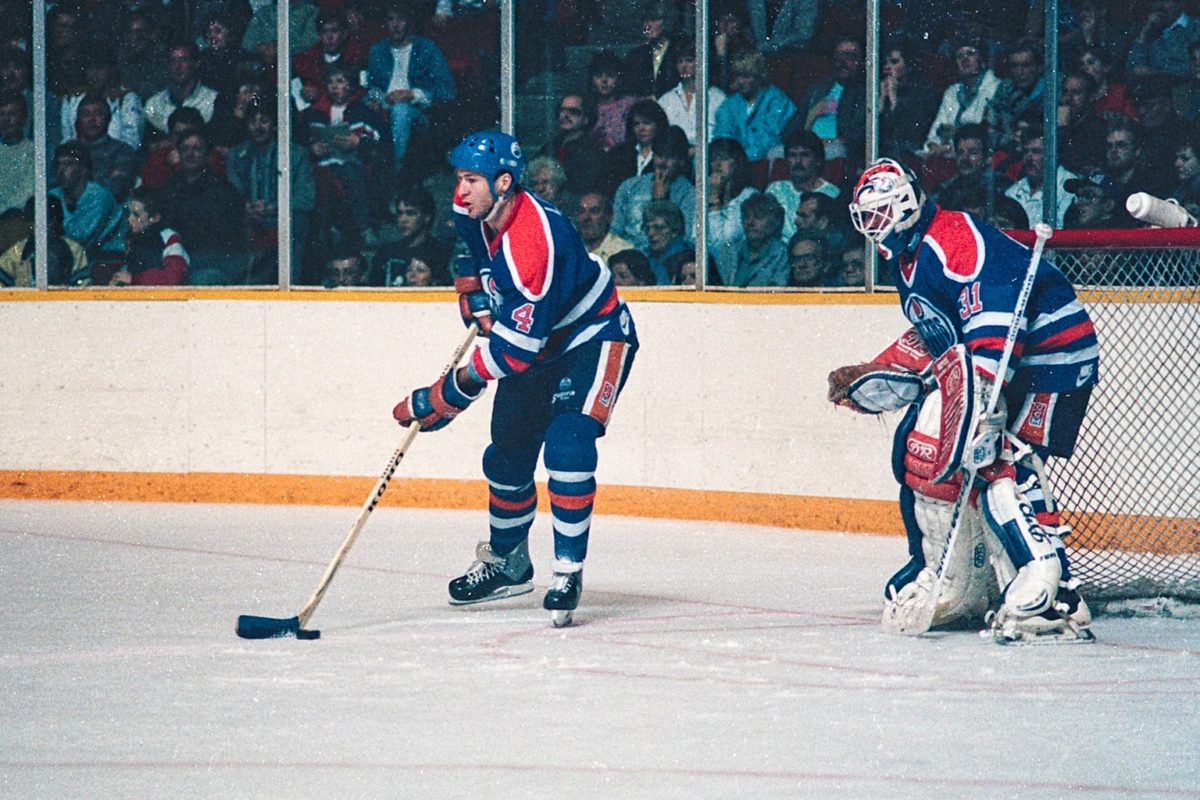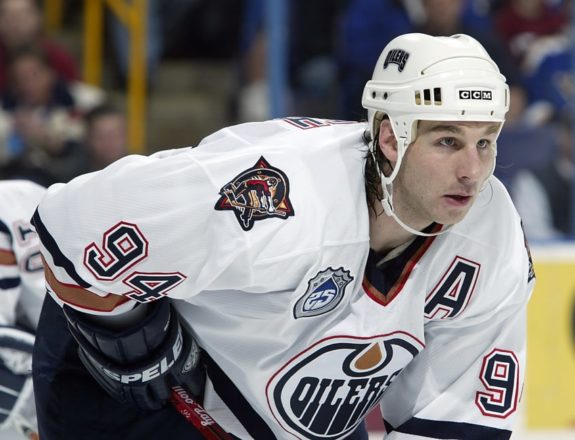After spending four decades with the Edmonton Oilers, from the ice to the bench to the boardroom, Kevin Lowe retired last Tuesday (Aug. 2) from his role as Vice Chair and Alternate Governor of the club.
Lowe’s retirement marks the end of an era that spanned virtually the Oilers’ entire NHL existence. With the exception of a four-year stint playing defence for the New York Rangers, he has been a part of the Oilers in some capacity since he was drafted in 1979 prior to the team’s inaugural NHL campaign.

Lowe was a member of all five Stanley Cup-winning teams in Oilers history, one of eight players to have his number retired by the club, and the all-time franchise leader in NHL games played – both regular season and playoffs. And he’s in the Hockey Hall of Fame.
Defenceman. Captain. Assistant coach. Head coach. General manager. Executive Vice President. President of Hockey Operations. All are titles the 63-year-old Quebec native has held with the Oilers.
His time in Edmonton hasn’t been without controversy, though. Fans became so infuriated by Lowe during his front office tenure that a group took out a full-page newspaper ad and ran an electronic billboard on one of Edmonton’s busiest roads demanding his dismissal.
Related: Kevin Lowe’s Jersey Retirement Gives Oilers Fans a Shot at Atonement
But like every hero’s story, this one has a redemptive arc, with Oil Country saluting Lowe when his No. 4 was raised to the rafters in a pre-game ceremony at Rogers Place last November. Never mind an article, nothing less than a full-length book could begin unpacking his legacy. But in honour of his number, which no Oilers player will ever wear again, here is a series of moments that help define No. 4.
Historic: Lowe’s Firsts for the Oilers
There can only be one first, and Lowe will forever be in the record books for the most significant such occasion in Oilers history.
First off, Lowe was Edmonton’s first-ever NHL draft pick, selected in the first round, 21st overall, at the 1979 NHL Entry Draft on Aug. 9, 1979. Then two months later, on Oct. 10, 1979, he scored the franchise’s first NHL regular season goal (which would also be its first power-play goal), backhanding the puck past Chicago Blackhawks netminder Tony Esposito while Edmonton was on the man-advantage midway through the opening period of their inaugural NHL game at iconic Chicago Stadium. Later in that same game, he was assessed the first five-minute major for fighting in franchise history, after dropping the gloves with Chicago forward Grant Mulvey.
And, of course, as one of the original Oilers, Lowe was in the lineup for all the team’s firsts: from the aforementioned inaugural game to the first of five Stanley Cup triumphs in 1984. If you made a list of the greatest highlights in Oilers history, Lowe was probably somewhere in the building for just about all of them.
Loyal: Lowe Comes Back to Edmonton
As the Oilers descended from perennial Stanley Cup contenders to the bottom of the standings, one by one their future Hall-of-Famers departed: Paul Coffey, Wayne Gretzky, Jari Kurri, Grant Fuhr, Glenn Anderson and Mark Messier. Lowe was the last to go, sticking with the Oilers until 1992 when he was traded to the New York Rangers.

Lowe was also just one of two of the aforementioned superstars that returned to play in Edmonton, but the only one who came back willingly (Anderson had a brief stint with the Oilers in 1996 after being claimed off waivers despite asking Edmonton general manager Glen Sather to not pick him up).
While the others spent the remainder of their career in major US markets, where the grass and the dollar bills were greener, Lowe returned from the bright lights of Broadway to the NHL’s northernmost locale on Sept. 28, 1996, signing as a free agent with the Oilers.
Lowe didn’t come back for the money, nor was it for a shot at another championship ring. No, he returned out of loyalty to the team and town he dearly loved.
Since Lowe’s departure four years earlier, the Oilers had missed the playoffs every season. In 1997, bolstered by the leadership of No. 4, Edmonton returned to the postseason and upset the Dallas Stars in the first round. They did it again in 1998, knocking off the heavily favoured Colorado Avalanche in the Western Conference Quarterfinals.
Lowe retired as a player on July 30, 1998, and immediately joined the Oilers staff as an assistant coach. Edmonton’s first NHL playoff series win without Lowe in the lineup didn’t come until 2006, the franchise’s 26th season in the league.
Fiery: Lowe Loses it in Dallas
One of Lowe’s most significant traits as a player was his competitive fire which sometimes burned a bit too hot, particularly when he hung his skates up and had to try and contain his emotions behind the bench or in the press box.

That was the case on April 13, 2000, at Reunion Arena in Dallas. After the Oilers had been thoroughly outplayed, losing Game 2 of the Western Conference Quarterfinals 3-0 to the Dallas Stars to fall behind 2-0 in the series, Lowe stormed back towards the dressing room, where he ripped down a partition curtain, which resulted in an aluminum curtain rod crashing down onto an arena attendant’s wrist. (From ‘Oilers get lowdown on how to play game’, The Globe & Mail, 04/13/00)
Then, a few years later, now in the role of Oilers general manager, Lowe’s fiery temper informed his approach during an acrimonious contract dispute with rising star centre Mike Comrie, a restricted free agent who had been held out of training camp in 2003 and requested a trade.
Lowe negotiated a trade with the Anaheim Mighty Ducks, but then said he would not make the deal unless Comrie paid the Oilers back $2.5 million in bonuses that the forward had received on his entry-level contract, an unprecedented demand that was almost universally viewed across the hockey landscape as being wholly unreasonable. The fitful emotions that Lowe harbored and harnessed as a player were now adversely clouding his judgement as an executive.
Comrie eventually was dealt to the Philadelphia Flyers on Dec. 16, 2003. While not Lowe’s finest hours, the Dallas meltdown and the Comrie drama were manifestations of how much he cared – and that is the greatest quality any competitor can have.
Bold: Lowe Goes All in for 2006 Cup Run
Lowe put nothing above winning. He wasn’t in the role of general manager to make friends or win popularity contests, and he certainly wasn’t afraid to make decisions of enormous consequence. Sometimes that worked brilliantly, others it proved disastrous, and the most famous example of each came within a year of each other.
At the 2006 Trade Deadline, the Oilers were clinging to the final playoff spot in the Western Conference and hadn’t appeared like anything approaching a Stanley Cup contender through the first three-quarters of the season. But Lowe saw something in his team and decided to go all-in. On March 8, 2006, the GM sent a first-round pick in 2006 and a 2007 third-round pick to Minnesota for former All-Star goalie Dwayne Roloson. Then on March 9, he got perennial 20-goal scorer Sergei Samsonov from the Boston Bruins in exchange for forwards Marty Reasoner and Yan Stastny, along with a 2006 second-round pick. They were exceptionally bold moves, considering the Oilers could almost as easily miss the postseason entirely.
The rest is history. The Oilers got into the playoffs as the eighth seed, stunned the Detroit Red Wings in the first round, then rolled past the San Jose Sharks and Mighty Ducks, all the way to Game 7 of the Stanley Cup Final, before ultimately being defeated by the Carolina Hurricanes. That remains Edmonton’s greatest playoff run since the team’s last Stanley Cup championship in 1990 and is the defining cherished memory for a generation of Oilers fans.

The opposite holds true for what went down on Feb. 27, 2007, when Lowe shockingly sent the heart and soul of the franchise, Ryan Smyth, to the New York Islanders at the trade deadline. While Smyth was an impending unrestricted free agent, the news came out of nowhere and left Oil Country stunned. Reportedly the two sides were $750,000 apart (‘Edmonton Oilers history: Team trades Ryan Smyth to New York Islanders’, The Edmonton Journal, 02/27/17) in their negotiations for a new contract, and rather than risk losing the beloved winger for nothing in free agency, Lowe opted for a return of Robert Nilsson, Ryan O’Marra, and a 2007 first-round pick (used to select Alex Plante) from the Isles.
The trade plunged the Oilers into the dreaded “Decade of Darkness” as Edmonton ended up winning just two of its final 20 games in the 2006-07 season and would not return to the NHL Playoffs until 2017. The sight of an emotional Smyth in an Edmonton airport preparing to depart his home of a dozen years haunts younger Oilers fans the same way that Gretzky’s teary-eyed press conference after being traded to Los Angeles in 1998 haunts older fans.
A few colorful adjectives don’t paint a full picture, but it wouldn’t be inaccurate to describe Lowe at his essence as a history-making, fiercely loyal competitor who approached everything with fiery dedication and without reservation.
Yes, Lowe’s Oilers’ legacy is a bit complicated. But the good far outweighs the bad. A two-time Oilers Community Service Award winner and three-time Oilers Defenseman of the Year, he left his mark in Oil Country at and away from the rink. Four decades. Two-thirds of the 63-year-old’s life. What a ride.
